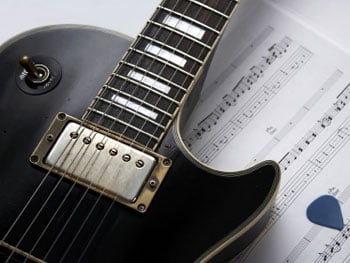Theory Glossary
Contents |
Theory Glossary
A list of musical theory terminology - the essential reference for theory students!
Note: Definitions of some terms were taken from Andrews Theory Lessons. Please check his lessons to learn even more!
--FretDancer69 03:33, 19 January 2008 (UTC)
A B C D E F G H I J K L M N O P Q R S T U V W X Y Z
A
Accidental: A note that falls outside the key signature.
Arpeggio: Notes from from a chord played one at a time.
Augmented Triad: Triad consisting of a root note, a major 3rd, an an Augmented 5th.
B
Bar: A regular collection of notes, each of the same duration in terms of the number of notes it contains. The duration of a bar in note terms is defined at the beginning by the time signature.
C
CAGED System: A framework to hang your understanding of the different major scales and associated chords on. There are 2 main parts - first, a selection of scales, and second some associated chord shapes that work in the same position as the scales.
Chord: A number of notes played together at the same time.
Circle of Fifths: An arrangement of musical keys in a circular format. Allows you to easily understand the relationship between keys, and work out the number of sharps and flats there are in each key.
Clef: Musical symbol used to indicate the pitch of the written notes, it is placed on one of the lines at the beginning of the staff.
D
Diminished Triad: Triad consisting of a root note, a minor 3rd, and a diminished 5th.
Dotted Note: A note with a small dot written after it. The dot adds a half as much again to the basic note's duration.
E
F
Flat: Lowers a note by one semi-tone. It is written as "b".
G
H
Harmony: An enhancement of a melody line by playing notes at the same time either higher or lower than the melody note itself.
Hexatonic Scale: A scale with six notes per octave.
I
Interval: The distance between two notes.
J
K
Key Signature: Shows the key that a piece is to be played in.It is written as a group of symbols at the beginning of the piece of music, listing either a number of sharps (#) or flats.
L
Ledger Line: Expresses notes that do not fall on the regular lines or spaces of the musical staff. A short line (slightly longer than the note) is drawn parallel to the lines on the staff (above or below as appropriate), corresponding to where the staff line would be if the note were in range.
M
Major Triad: Triad consisting of a root note, a 3rd, and a Perfect 5th.
Minor Triad: Triad consisting of a root note, a minor 3rd, and a Perfect 5th.
Mode: A variaton of a scale used to create different effects within a song. The modes are: Ionian, Dorian, Phrygian, Lydian, Mixolydian, Aeolian and Locrian. Each mode possesses a different formula. The Ionian mode is another name for the Major Scale and therefore posseses the same formula. The Aeolian mode is another name for the Minor Scale and it too, possesses the minor scale's formula.
N
O
Octave: Interval between two notes with half or double its frequency. These two notes share the same name.
P
Pentatonic Scale: A scale with five notes per octave.
Pitch: The perceived fundamental frequency of a sound.
Powerchord: Two notes played together, a root note and a Perfect 5th interval, sometimes the root note's octave is added as well.
Q
R
Rest: An interval of silence in a piece of music, marked by a sign indicating the length of the pause. Each rest symbol corresponds with a particular note value.
Root Note: The note(s) that define the sound of the scale. The scale is named after its root note.
S
Scale: A set of notes that have a particular sound or feeling to it.
Sharp: Raises a note by one semi-tone. It is written as "#".
Slur: Symbol indicating that the notes it embraces are meant to be played without separation.
Stave: The series of vertical lines that music notation is based around. Staves are composed of five lines, these lines do not represents the strings on the guitar. --> Go to Music Notation Lesson <--
T
Time Signature: Used in sheet music. Specifies how many beats are in each measure and one note value constitutes one beat.
Transposition: Process of moving a collection of notes up or down in pitch by a constant interval.
Triad: The simplest form of a chord that contains at least 3 notes, root note, major third and perfect 5th. There are also other types of triads with different formulas.






